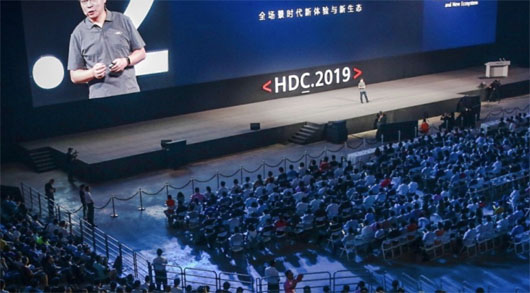Special to WorldTribune, August 13, 2019
A friend with close ties to both Silicon Valley and China’s tech scene shared the story about the debut of Huawei’s HarmonyOS last week. As with any news related to China’s largest telecom equipment maker, there will be pointless partisan political sniping about the “why.” Why did Huawei need to develop a whole new operating system? Why is Google pulling support for Android on Huawei’s hardware? But the “why” is not the interesting question; it’s the “what” as in “what happens now?”

While I don’t have any insider info about Huawei, this is an interesting topic of discussion because of reports that HarmonyOS is a microkernel-based operating system (OS). In layman’s terms, a kernel is the base code for a device’s OS. A monolithic kernel runs in a single memory space while a microkernel segments the code to run into smaller modules that can run independent of each other. An example of a monolithic kernel operating system is Linux. Google took the Linux source code and developed a “fork” of that code base to develop a new OS called Android—which is basically Linux that is easily usable by a normal person without a computer science degree or autism.
In the past few years, developers and academics have touted microkernel operating systems as the best option for IoT and other smart devices. When I worked at Microsoft, there was a grand plan of scrapping the aging Windows Embedded code base, rife with decades-old legacy code, and starting over to create a scalable new OS that would work on everything from home appliances to industrial machinery (Spoiler alert: That never happened). Prior to Huawei’s HarmonyOS, the only other example of a microkernel-based OS I’d heard of was Google’s Project Fuchisa.
It is interesting to bring up Google and Huawei again when discussing microkernel OS development. If a recent report from the tech industry rumor website “The Information” is to be believed, Huawei had up to 100 of their engineers on Google’s main campus in California jointly working on hardware and software services for years. But I’m sure there were never any unauthorized transfers of intellectual property…
The Unanswered Questions Of Huawei’s HarmonyOS
Let’s get back to the HarmonyOS and what it means for Huawei’s smartphone business in the short term. We’ve been told by Huawei that HarmonyOS shouldn’t be viewed as an Android replacement, then what is it? Overall, there are few details about HarmonyOS but there are many open questions:
- Is this a fork of Google Fuchsia or are the Chinese trying to make their own microkernel OS from scratch? Probably not a good idea since forking an existing monolithic kernel code base is already a challenge (and one only has to point to China’s “Red Flag Linux” to see their success rate)
- If Huawei wants HarmonyOS as the in-house operating system exclusively for their Honor line of phones that the company only sells in China, then isn’t that VERY limiting for their overall global market share compared to Android?
- What’s the incentive for Android app devs outside of China to recompile all of their current apps for HarmonyOS? Put aside national pride and be honest: Chinese consumers prefer the more open Android OS because they typically install freemium games at best and are notorious for sideloading pirated apps for free (which is nearly impossible to do on Apple’s iOS platform)
Good answers to these difficult questions are “make or break” for the success of the Huawei HarmonyOS.
Some Armchair Product Management For Huawei
If I was running the HarmonyOS division, the first thing I’d do is have the engineers/testers get it stable on the in-house developed system on a chip (SoC) called the Huawei Kirin. As a backup, ensure HarmonyOS runs well on the MediaTek Helio series of ARM SoCs. While some Huawei execs might balk at Taiwan-owned MediaTek as the secondary supplier, the fact is that MediaTek’s supply chains are intertwined with China and make the most sense to produce devices in any realistic volume. Once these SoCs are verified for HarmonyOS, they become “reference platforms” that can be given away to the top Chinese OEMs like BBK, Haier, Hisense, and Xiaomi. No upfront licensing fees for the OS gives the OEMs a huge incentive to install and use HarmonyOS on all devices.
Of course, HarmonyOS development and support is not cheap. There has to be some way for Huawei to get a return on their investment in the HarmonyOS. The easiest way of doing that is to hook those various HarmonyOS-powered devices up with China’s powerful service providers like Tencent and Alibaba. By offering profit-sharing deals between those providers (administered via software tools and backend services by Huawei), everyone makes some money. Best of all, this is a low-risk scenario because we all know this business model works; it’s basically what Google did with Android to crush RIM BlackBerry, Palm, and Microsoft in the mobile device marketplace.
In the end, the Huawei HarmonyOS serves as the basis for a Chinese-centric ecosystem of smart devices and services that would rival Google in China… and once it is seen as a viable alternative to Google, they could release localized versions to the rest of the world.
Only a fool would be blind to the fact that a significant cohort of consumers are wary of Google’s perceived monopolistic practices. However, consumers do not currently have any viable alternatives in the marketplace. This fact represents a major opportunity for Huawei to be that alternative if they play their cards right.

You must be logged in to post a comment Login